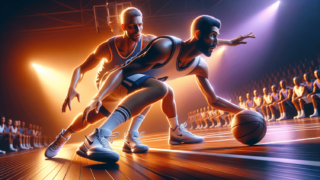
Ever tuned into a basketball game and found yourself mystified by a fast-paced play that left the defenders scrambling? Well, say hello to the double screen! In this blog post, we’ll take an in-depth look at what a double screen is, how it works, and why it’s such a powerful weapon in a basketball team’s offensive arsenal. So lace up your sneakers, grab your clipboard, and let’s delve into the dynamic world of double screens in basketball together. Whether you’re a casual fan or an aspiring coach, by the end of this post, you’ll feel like a real expert on the double screen!
What’s a Double Screen in Basketball?
A double screen in basketball is an offensive play where two teammates set stationary screens side-by-side for another player, usually the ball handler or a shooter. This orchestrated move aims to create an open shot opportunity, confusion among defenders, or force defensive switches, ultimately providing the offensive team with a strategic advantage.
Unlocking the Power of the Double Screen
The double screen is an effective tool in an offensive coach’s toolbox, but what makes it so impactful on the basketball court? In this section, we’ll uncover the fundamentals of a double screen, its purpose, and the different components that make it a popular choice among top teams.
Why Double Screens are Essential in Basketball Tactics
A double screen adds another layer of complexity to a team’s offense, making it more challenging for the defense to read and react in time. It presents multiple scoring options to the team, demands effective communication among defenders, and often leads to mismatches, which the offense can exploit. In basketball, where split-second decisions can make a significant difference, the double screen is an offensive weapon worth mastering.
Setting Up the Double Screen: An In-depth Look
Establishing a solid double screen requires coordination and precise execution from all the players involved. Let us examine the various elements of setting up a double screen, the roles of each player, and some tips to make it more efficient.
Roles of Players in a Double Screen
Three key players are involved in executing a double screen:
- Screener 1: The first teammate who sets the initial screen.
- Screener 2: The second teammate who sets the screen adjacent to Screener 1, creating a “wall” for the ball handler or shooter to maneuver around.
- The Cutter: The player who uses the double screen to break free from their defender, either for an open shot or to create further offensive opportunities.
Each player must understand and carry out their roles effectively for the double screen to truly unleash its potential.
Steps to Set Up a Successful Double Screen
- Choose the right personnel: Select players with good communication and screening abilities; typically, this involves two forwards or a forward and a center, and a guard or a small forward as the cutter.
- Ensure proper spacing: Maintaining adequate distance between the players involved is crucial to prevent defenders from easily moving through or around the screen.
- Commit to the screens: The screeners must hold their positions without moving or leaning into the defenders, as this can result in offensive fouls.
- Perfect the timing: The cutter should anticipate the moment when the screens are in place and begin their cut at the right time.
- Read the defense: All players must observe the defenders’ reactions and adjust their moves accordingly to maximize scoring opportunities.
Discovering Variations of the Double Screen
Coaches can harness the basketball double screen’s versatility by incorporating different variations that best suit their team’s strengths and exploit the opposition’s weaknesses. Let’s delve into some popular double screen variations and their tactical advantages.
Double Screens with a Pick and Pop
In this variation, the second screener, after setting the screen, moves out to the perimeter, creating a shot opportunity for themselves if their defender is caught in the double screen. This tactic works well if the second screener can shoot effectively from the outside, putting additional pressure on the defense.
Double Screens with a Rolling Big Man
As the cutter makes a move towards the basket, the first screener in this variation rolls inside too. Another option is for the second screener to roll inside, diving towards the basket. By doing this, the offense can further disorient the defense, potentially creating an open shot for the rolling player or their teammates.
Double Back Screens
In this set-up, both screeners position themselves on the weak side of the court, with the cutter starting on the strong side. As the ball handler moves towards the weak side, the cutter can use the double screen to cut across the court and receive a pass. This variation requires swift footwork and precise timing to effectively exploit the defense.
Double Screens for Inbounds Plays
During sideline or baseline inbounds plays, a well-executed double screen can be invaluable in catching defenders off guard, leading to quick baskets. The inbounder often acts as one of the screeners, setting a makeshift double screen for a teammate cutting toward the ball.
Defending Against the Double Screen: The Challenges and Solutions
Defending against a double screen can be quite challenging, but with proper communication, focus, and strategy, it’s possible to contain its threat. In this section, we’ll go over some of the vital defensive strategies teams can employ against a double screen and the challenges they may face.
Communication, Communication, Communication!
Knowing when a double screen is coming is half the battle won. Effective communication among defenders can help identify the imminent threat and coordinate an appropriate response, such as a switch or a fight-through strategy.
Fighting Through the Double Screen
Defenders can choose to fight through the double screen by maneuvering around or between the screeners, staying close to the cutter, and contesting their shot. While this approach may work against less skilled opponents, it can be tough to execute against well-coordinated teams and presents the risk of mismatches and fouls.
Switching on the Double Screen
Another defensive option is to switch, where the defenders exchange their coverage assignments. While this tactic can eliminate the immediate threat, it can create mismatches, particularly when a smaller guard is forced to defend against a larger forward or center. Teams need to make quick decisions and be prepared to rotate and help their teammates when employing this strategy.
Utilizing the “Show and Recover” Technique
One player fights through the double screen, while the other one briefly steps out to slow down the cutter, then quickly recovers their initial assignment. This tactic puts pressure on the cutter while also minimizing the risk of mismatches, but it demands perfect coordination and quick reflexes to execute effectively.
Learning from the Best: Notable Double Screen Plays in Basketball History
The double screen has been a part of some of the most memorable plays and incredible moments in basketball history. Here, we’ll take a glimpse at some famous double screen plays that made a lasting impact on fans and players alike.
Reggie Miller’s Clutch Performance
Known for his ability to shoot under pressure, Reggie Miller’s game-tying three-pointer in Game 4 of the 1998 Eastern Conference Finals showcased his skill in navigating through double screens. With just seconds left on the clock and the Indiana Pacers trailing by three, Miller successfully utilized a well-executed double screen to create enough space for the much-needed shot.
Ray Allen’s Iconic Shot in the NBA Finals
During Game 6 of the 2013 NBA Finals, sharpshooter Ray Allen hit a game-tying three-pointer with less than six seconds left, sending the game into overtime. This shot, considered one of the most clutch moments in NBA history, was made possible by Allen’s expert navigation through a double screen, allowing him to catch the ball with just enough space to sink the game-changing shot.
Steph Curry’s Double Screen Mastery
Two-time NBA MVP Steph Curry, known for his exceptional shooting skills, repeatedly demonstrates his ability to exploit double screens to break free from defenders and make open shots. His quick release and deep range make him a nightmare for defenders, particularly when paired with well-coordinated double screens by his teammates.
Practical Drills to Master the Double Screen
Like any skill in basketball, practice is the key to mastering the double screen. Coaches and players can incorporate various drills into their training sessions to simulate game-like scenarios and familiarize themselves with this potent offensive tool. Here are a few practical drills to consider adding to your practice regimen:
The Three-Player Double Screen Drill
This drill involves two players setting up as screeners for a third player (the cutter). Each player takes turns acting as a screener or the cutter, improving their understanding of each role while gaining better timing and communication.
Double Screen Shooting Drill
By adding a fourth player (the passer) to the equation, this drill focuses on simulating shots that are created off double screens. The cutter practices their footwork, coming off the screen to receive the ball, and shooting within a set time limit.
Four-on-Four Double Screen Drill
This drill involves an offense and defense setup, with defense tasked to defend against a double screen. This exercise helps the offense practice their execution, while the defense develops their communication and decision-making skills in dealing with double screens.
The basketball double screen is an incredible asset to any team’s offense when executed correctly. Developing an understanding of this play and incorporating it into your team’s tactics can unlock new scoring opportunities and give you a competitive edge on the court. So, practice diligently, communicate effectively, and watch your offense soar to new heights with the power of the double screen!
Identifying Common Mistakes and How to Fix Them
Although executing a double screen might seem straightforward at first glance, several common mistakes could hinder the play’s effectiveness. In this section, we identify these pitfalls and suggest strategies to overcome them, ensuring a smooth and successful double screen play.
Incorrect Screening Angles
Creating an effective double screen requires both screeners to be at precisely the right angle. If their angles are off, the cutter won’t have the space they need to get an open shot, and the defenders will have an easier time navigating around the screens. To fix this problem, screeners should practice setting screens at the correct angle with their backs parallel to the baseline or sideline, based on the play design.
Improper Timing and Execution
Timing is crucial when executing a double screen, as it ensures a synchronized effort. Screeners setting their screens too early or too late, or a cutter making their cut prematurely or too slow, can lead to a disrupted play. To mitigate this issue, teams should consistently practice double screens, focusing on timing and the specific steps needed to set up a powerful screen.
Illegal Screens
Illegal screens, where a screener leans into the defender or moves their feet during the screen, are a common problem when setting up double screens. An illegal screen can easily result in an offensive foul and possession change. Screeners should train themselves to maintain a stationary stance, keeping their feet shoulder-width apart, and avoiding leaning or extending their arms during the play.
Understanding Advanced Concepts: The Ghost Screen and Staggered Double Screen
In addition to the double screen variations we’ve discussed earlier, there are other advanced concepts that coaches and players can add to their offensive arsenal. Let’s take a look at a couple of these unique double screen plays and their potential benefits.
The Ghost Screen
In a ghost screen, one of the screeners slips away from the double screen before setting it completely. This slip can catch the defense by surprise, as they might be expecting a full double screen. The ghost screener can either roll to the basket or pop out towards the perimeter for a shot, providing the offense with an additional scoring option.
Staggered Double Screen
A staggered double screen involves setting two screens at different locations along the cutter’s path, instead of side-by-side. This variation can confuse the defender and make it even more challenging for them to stay with their offensive assignment. The staggered double screen requires fluid spacing and impeccable timing but, when executed correctly, can create significant scoring opportunities for the offense.
Studying Past and Present Double Screen Masters
Learning from the best can be a powerful way to improve your understanding of the double screen concept. By studying past and present masters of the double screen, players and coaches can gain insight into what makes this basketball play so impactful and identify tactics that can be adapted to their own game.
Historic Double Screen Experts
Some historic players known for their double screen expertise include:
- John Stockton and Karl Malone (Utah Jazz)
- Larry Bird and Kevin McHale (Boston Celtics)
- Steve Nash and Dirk Nowitzki (Dallas Mavericks)
By watching these players in action, one can identify what made their double screens so successful, from their spacing and cutting to communication and timing.
Modern Double Screen Masters
Current NBA players recognized for utilizing double screens effectively include:
- Klay Thompson (Golden State Warriors)
- James Harden (Brooklyn Nets)
- Bradley Beal (Washington Wizards)
Studying their games can provide a valuable glimpse into the evolution of double screens and allow players and coaches to discover innovative ways to implement this powerful offensive tool.
Mastering the double screen demands a deep understanding of the play’s different components, variations, challenges, and advanced concepts. By practicing consistently, studying the greats, and implementing the strategies discussed here, coaches and players can enhance their offensive capabilities and take their game to the next level.
Frequently Asked Questions
In this FAQ section, we address some common questions related to double screens in basketball. This knowledge will not only enhance your understanding of the concept but also prepare you to implement and effectively deal with double screens in various game situations.
1. What is the primary goal of a double screen in basketball?
The primary goal of a double screen is to create open shot opportunities for the offensive team by freeing up a player (the cutter) from their defender, causing confusion among the opposing team, and possibly forcing defensive switches that can result in mismatches.
2. How do you effectively defend against a double screen?
Defending against a double screen requires effective communication among defenders, making quick decisions on whether to fight through the screen, switch assignments, or utilize a “show and recover” technique. Proper anticipation and defensive rotations also help in containing its threat.
3. How do you set a legal screen in basketball?
To set a legal screen, you must establish a stationary position with your feet shoulder-width apart and maintain that stance without leaning or extending your arms during the play. Moving or leaning into defenders can result in offensive fouls and possession change.
4. Can a double screen be used during inbounds plays?
Yes, double screens can be successfully utilized during sideline or baseline inbounds plays to catch defenders off guard, leading to quick baskets. The inbounder often acts as one of the screeners, setting a makeshift double screen for a teammate cutting toward the ball.
5. Are there variations of the double screen?
Yes, there are several variations of the double screen, such as the pick and pop, rolling big man, double back screen, and staggered double screen. These variations offer distinct tactical advantages and can be adapted to match a team’s strengths and exploit the opposition’s weaknesses.
6. What is a ghost screen?
A ghost screen occurs when one of the screeners slips away from the double screen before setting it completely. This slip can surprise the defense, which may be expecting a full double screen, and create additional scoring options for the offense.
7. What is the main difference between a staggered double screen and a regular double screen?
In a staggered double screen, the two screens are set at different locations along the cutter’s path, rather than side-by-side. This variation can make it more challenging for defenders to stay with their offensive assignment and create more significant scoring opportunities for the offense.
8. How does a double screen help create mismatches on the court?
A double screen can lead to switches in defensive assignments to avoid an open shot. However, these switches can result in mismatches, such as a smaller guard being forced to defend against a larger forward, thus providing the offensive team with a strategic advantage.
9. How do you ensure proper spacing when setting up a double screen?
Maintaining adequate distance between the players involved in a double screen is essential. Screeners should set their screens close enough to each other to prevent defenders from easily moving through the gap but far enough apart to avoid being called for offensive fouls or impeding each other’s movements.
10. How can I practice double screens effectively?
Practicing double screens effectively requires implementing various drills into training sessions, such as the three-player double screen drill, double screen shooting drill, and four-on-four double screen drill. These exercises simulate game-like scenarios to familiarize players with the play and improve their timing and communication skills.
11. How do I choose the right players for a double screen formation?
Select players with good communication skills and screening abilities, typically involving two forwards or a forward and a center as screeners, while a guard or a small forward acts as the cutter. The screeners should also be effective in rolling or popping out for perimeter shots.
12. Why is timing crucial when executing a double screen?
Timing is crucial for a double screen, as it ensures synchronized execution among the players involved. Proper timing allows the cutter to make their move when the screens are in place, maximizing the play’s chances of success.
13. Can I learn from historic and modern double screen experts?
Yes, studying past and present masters of the double screen, like John Stockton and Karl Malone, Larry Bird and Kevin McHale, or Klay Thompson and Stephen Curry, can offer valuable insights into what makes the play so impactful and help players and coaches identify tactics they can adapt to their game.
Featured Posts
- No pillar pages found.





